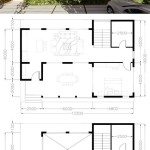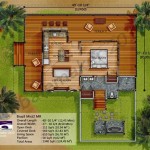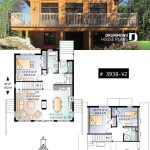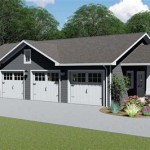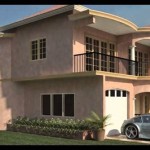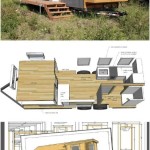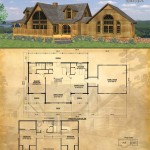One Bedroom House Floor Plans With Loft: Maximizing Space and Style
The increasing demand for efficient and versatile living spaces has propelled the popularity of one-bedroom house floor plans with a loft. This architectural design effectively utilizes vertical space, transforming a compact footprint into a comfortable and functional home. These plans cater particularly to individuals, couples, or small families seeking affordable housing options without compromising on style or functionality.
Lofts can serve a variety of purposes, adding significant value to the overall living experience. They can function as guest bedrooms, home offices, creative studios, or additional storage areas, adapting to the evolving needs of the homeowner. The integration of a loft also introduces a unique architectural element, often characterized by exposed beams, high ceilings, and an open, airy atmosphere. This design approach allows for more natural light to permeate the living space, creating a brighter and more inviting ambiance.
The selection of a suitable one-bedroom house floor plan with a loft requires careful consideration of several factors, including the size and configuration of the lot, the homeowner's lifestyle and preferences, and local building codes and regulations. A well-designed floor plan will optimize the use of available space, ensuring that each area is functional and contributes to the overall flow and harmony of the home.
Key Considerations for Designing One-Bedroom House Floor Plans with Loft
Designing a one-bedroom house floor plan with a loft involves careful planning and attention to detail. Several key considerations will influence the final design and ensure that the space meets the needs and preferences of the homeowner.
1. Loft Accessibility and Safety: The accessibility of the loft area is paramount. The design should incorporate a safe and convenient access point, typically through a staircase or ladder. Staircases are generally preferred for their ease of use and safety, particularly for individuals with mobility issues or those who plan to use the loft frequently. Building codes often dictate specific requirements for staircases, including minimum width, rise, and run dimensions. Ladders, while space-saving, may be less suitable for everyday use and should be considered carefully based on the potential users and the intended function of the loft. Safety is another critical aspect. Railings or balustrades are essential to prevent falls, and the loft floor must be structurally sound enough to support the intended load. Smoke detectors and fire extinguishers should also be readily accessible in both the main living area and the loft.
2. Zoning and Privacy: Effective zoning separates distinct functional areas within the limited square footage. In a one-bedroom house plan with a loft, the ground floor typically houses the main living area, kitchen, bathroom, and the primary bedroom. The loft provides an opportunity to create a separate zone for activities such as working, relaxing, or accommodating guests. Visual and acoustic privacy are important considerations when designing the loft. Partial walls, screens, or strategic furniture placement can help to delineate the loft area and provide a sense of enclosure. Soundproofing materials can also be incorporated into the floor and walls to minimize noise transmission between the loft and the main living area. The placement of windows and natural light sources should be carefully planned to ensure adequate illumination and ventilation in both zones.
3. Space Optimization and Storage: Maximizing the use of available space is crucial in a small home. Efficient storage solutions are essential to minimize clutter and maintain a comfortable living environment. In the main living area, multi-functional furniture, such as sofa beds or storage ottomans, can provide additional seating and storage options. Built-in shelving and cabinets can also be incorporated to maximize vertical space. In the kitchen, compact appliances and clever storage organizers can help to optimize counter space and cabinet capacity. The loft area offers opportunities for creative storage solutions, such as built-in bookshelves, under-eave storage, or custom-designed closets. Vertical storage solutions are particularly effective in lofts with sloped ceilings. It is also important to consider the flow of movement within the home, ensuring that each area is easily accessible and functional.
Popular Loft Configurations and Design Styles
One-bedroom house plans with lofts exhibit a diverse range of configurations and design styles, adapting to various aesthetic preferences and functional requirements.
1. The Open Loft: This design approach maintains a completely open connection between the main living area and the loft. This promotes a sense of spaciousness and allows for maximum natural light to permeate the entire home. Open lofts are often characterized by exposed beams, high ceilings, and minimal visual barriers. This design style is particularly well-suited for individuals who appreciate a modern, minimalist aesthetic and prioritize a sense of openness and connectivity within the home. However, it is important to note that open lofts offer limited privacy and sound insulation.
2. The Partially Enclosed Loft: This configuration incorporates partial walls or screens to delineate the loft area while still maintaining a visual connection with the main living space. This approach provides a balance between privacy and openness, allowing for a degree of separation without completely isolating the loft. Partially enclosed lofts can be customized to suit specific needs and preferences. For example, a partial wall could be used to create a small home office or a reading nook, while still allowing for natural light to flow into the main living area. This design style is particularly well-suited for individuals who desire some privacy in the loft but still want to maintain a sense of connection with the rest of the home.
3. The Fully Enclosed Loft: This design approach creates a fully enclosed room on the upper level, offering maximum privacy and sound insulation. This configuration is ideal for individuals who require a dedicated guest bedroom, a home office for video conferencing, or a quiet retreat. Fully enclosed lofts typically include a door for access and windows for natural light and ventilation. This design style is particularly well-suited for individuals who prioritize privacy and require a distinct separation between the loft and the main living area. However, it is important to ensure that the fully enclosed loft complies with local building codes and regulations regarding minimum room size, ceiling height, and ventilation requirements.
Factors Influencing the Overall Cost of One-Bedroom House Plans With Loft
The cost of building a one-bedroom house with a loft varies depending on numerous factors including location, materials, and complexity of design.
1. Location and Labor Costs: Geographical location exerts a significant influence on construction expenses. Areas with higher costs of living generally experience elevated labor rates and material expenses. Furthermore, local building codes and permit fees can impact the overall budget. Thoroughly researching and understanding the prevailing labor and material costs in the intended construction area is crucial for accurate financial planning.
2. Materials and Finishes: The selection of building materials and interior finishes significantly contributes to the overall cost. High-end materials such as hardwood flooring, custom cabinetry, and premium appliances can substantially increase the budget. Conversely, opting for more affordable alternatives like laminate flooring, stock cabinetry, and standard appliances can help control expenses. Energy-efficient windows, insulation, and HVAC systems can lead to long-term savings on utility bills, offsetting the initial investment.
3. Design Complexity and Customization: The complexity of the floor plan and the extent of customization directly impact construction costs. Intricate designs involving unusual angles, curved walls, or custom-built features require more labor and specialized skills, resulting in higher expenses. Opting for a simpler, more straightforward design can significantly reduce construction costs. Pre-designed floor plans offer a cost-effective alternative to custom designs, while still providing a range of options to suit individual needs and preferences.
In summary, one-bedroom house plans with loft offer a compelling solution for individuals seeking to maximize space and create a functional and stylish living environment. Careful consideration of design elements, accessibility, zoning, and storage solutions will ensure the creation of a comfortable and well-utilized home. The selection of a suitable configuration and design style should align with the homeowner's lifestyle and aesthetic preferences. By addressing these key considerations, homeowners can create a one-bedroom house with a loft that perfectly complements their individual needs and aspirations.

Image Result For 1 Bedroom With Loft House Plans Plan One Small

Floor Plan 1e Junior House Lofts

1 5 Bedroom Bathroom Loft Apartment Floor Plan Small House Plans With

Tiny House Floor Plan With Bedroom Loft

Studio And 1 Bedroom Apartment Floor Plans The Lofts On La Brea

Ranch Style House Plan 1 Beds Baths 896 Sq Ft 771 One Bedroom Plans Small Floor

Tiny House Floor Plan With Bedroom Loft

Small House 4x7 Meters With 1 Bedroom Loft Bed Shed Roof Samhouseplans

Mediterranean Style House Plan 1 Beds Baths 768 Sq Ft 111 One Bedroom Plans

Tiny House Floor Plan With Bedroom Loft

